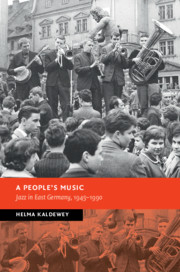Book contents
- A People’s Music
- New Studies in European History
- A People’s Music
- Copyright page
- Contents
- Figures
- Preface
- Chronology
- Abbreviations
- Chapter 1 Jazz in Weimar and Nazi Germany, 1918–1945
- Chapter 2 Jazz in the Soviet Zone, 1945–1949
- Chapter 3 Jazz in the Founding Years of the GDR, 1949–1961
- Chapter 4 Jazz Behind the Wall, 1961–1971
- Chapter 5 The Rise of New Jazz, 1971–1979
- Chapter 6 “A National Treasure”: Jazz Made in the GDR, 1980–1990
- Archival Sources
- Appendix
- Bibliography
- Index
Chapter 6 - “A National Treasure”: Jazz Made in the GDR, 1980–1990
Published online by Cambridge University Press: 02 December 2019
- A People’s Music
- New Studies in European History
- A People’s Music
- Copyright page
- Contents
- Figures
- Preface
- Chronology
- Abbreviations
- Chapter 1 Jazz in Weimar and Nazi Germany, 1918–1945
- Chapter 2 Jazz in the Soviet Zone, 1945–1949
- Chapter 3 Jazz in the Founding Years of the GDR, 1949–1961
- Chapter 4 Jazz Behind the Wall, 1961–1971
- Chapter 5 The Rise of New Jazz, 1971–1979
- Chapter 6 “A National Treasure”: Jazz Made in the GDR, 1980–1990
- Archival Sources
- Appendix
- Bibliography
- Index
Summary
By the last decade of the GDR, jazz had become a cherished national art form, a process of legitimization thatexplores in detail even as it chronicles the collapse of the East German state as a whole. In the 1980s, prominent GDR jazz musicians toured both the Eastern and Western blocs, turning free jazz that was “made in the GDR” into a desirable export from a progressive socialist country. Socialist leaders sought to showcase that prestige: in 1985 the GDR held its first “national” jazz festival in Weimar, a city that symbolized German humanist and democratic heritage. Despite the popularity of jazz as a “national” art form by this time, including the formation of the first national jazz orchestra, larger political currents would catalyze the collapse of the GDR within a few short years. To conclude this account, this chapter details the fall of the Berlin Wall through the eyes of key members of the jazz scene interviewed for this book. A brief epilogue explores the last chapter in the history of East German jazz, examining the months after the fall of the wall and the dismantling of the social and political apparatus that had nurtured jazz for so many years.
Keywords
- Type
- Chapter
- Information
- A People's MusicJazz in East Germany, 1945–1990, pp. 244 - 279Publisher: Cambridge University PressPrint publication year: 2019

